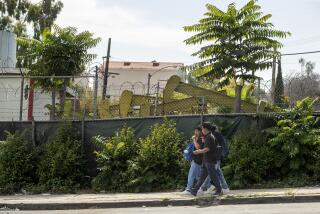State High Court Allows Injunctions to Restrict Gangs
- Share via
SAN FRANCISCO — The California Supreme Court, putting public safety concerns over civil liberties, ruled Thursday that cities can prohibit suspected gang members from engaging in legal activities such as associating on street corners or annoying residents.
In a decision that divided the justices and sparked flaming rhetoric, the high court said cities may continue to use public nuisance laws to obtain injunctions that prevent suspected gang members from engaging in otherwise legal activities.
The ruling, overturning a Court of Appeal decision, upheld a San Jose injunction that barred 38 suspected Latino gang members from “standing, sitting, walking, driving, gathering or appearing anywhere in public view” with each other in a four-block neighborhood.
“Liberty unrestrained is an invitation to anarchy,” Justice Janice Rogers Brown wrote for the court. “Freedom and responsibility are joined at the hip.”
Police officials in Orange County and across the state hailed the decision as a nod to their ongoing struggle to stifle gang violence.
“The Supreme Court, deeply divided or not, is finally realizing how serious a problem gang violence is,” said Police Sgt. Bob Clark of Santa Ana, one of the county’s most gang-plagued cities.
The decision removes a legal cloud over such gang-abatement injunctions, which have been growing in popularity in California as a tool to combat gangs. Nearly a dozen California communities have won such injunctions, and more cities are expected to seek them as a result of Thursday’s ruling.
Though the decision applies specifically to a San Jose case, it was of particular interest to officials in Westminster, which in 1993 won an injunction banning 59 members of the “West Trece” gang from a 25-square-block neighborhood.
The city declared the gang a public nuisance and specifically banned the members from “standing, sitting, walking, driving, gathering or appearing anywhere in public view” in the neighborhood.
The injunction was struck down as unconstitutional by Superior Court Judge Richard J. Beacom, who characterized it as “impermissible invasion of privacy” under the 1st Amendment. His ruling is now under appeal.
Westminster Police Capt. Andy Hall said Thursday’s ruling is “a good thing all the way around. . . . The court recognizes how important it is for cities to have the ability to use laws in this manner.”
Bans on assembly by gang members “are minimally intrusive and an extraordinary way of protecting people,” Hall said.
Gov. Pete Wilson, in a statement from China where he is on a trade mission, praised the court for upholding “an important tool in our efforts to put an end to gangs that terrorize the law-abiding residents of our cities.”
“Today’s ruling sends a clear message to gang members,” Wilson said. “The safety of our communities takes priority over gang members’ freedom to hang out on street corners and prey on the innocent.”
Los Angeles Dist. Atty. Gil Garcetti, who made the anti-gang strategy a focus of his reelection campaign last year, said Thursday he may now seek even broader injunctions to restrict gangs. Residents in several Los Angeles County communities with these injunctions also expressed relief that they can remain in force.
But civil libertarians were troubled by the ruling. They argue that these injunctions go too far, violating such basic constitutional rights as freedom of association. Similar concerns also fractured the state high court, producing four separate opinions.
“No doubt Montesquieu, Locke and Madison will turn over in their graves,” wrote Justice Stanley Mosk in a dissent, noting the majority opinion invoked the names of these noted advocates of liberty.
Mosk chastised the court for depriving “simple rights to a group of Latino youths who have not been convicted of a crime.”
Mark Silverstein, an American Civil Liberties Union attorney who successfully argued against the Westminster ban, said the ACLU considers Thursday’s ruling “extremely unfortunate” because it does not address what the organization considers one of the critical issues involving such bans: How do the police identify gang members?
Such identifications generally are made by tattoos and clothing, Silverstein said.
“This permits cities to close off entire neighborhoods to Latino youths who dress in a certain style or associate with youths who dress in that style,” Silverstein said. “We still think that’s going too far.”
In the case before the court, residents of a San Jose neighborhood said they had been terrorized by a Latino gang. Its members congregated on lawns and sidewalks, drinking, smoking marijuana and snorting cocaine “laid out in neat lines on the hoods of residents’ cars,” Brown wrote for the court majority.
Residents complained they had become prisoners in their homes, friends refused to visit and children could not play outside. Gang members took over sidewalks and driveways, urinated in public and covered everything with graffiti, the residents said.
After nearly 500 arrests failed to resolve the problem, the San Jose city attorney’s office filed a lawsuit under a public nuisance law and obtained a court injunction in 1993 prohibiting alleged gang members from associating in the neighborhood.
The injunction also prevented the 38 named individuals from carrying pens, nails or razor blades, from climbing trees or fences, and from wearing gang colors in the neighborhood.
Each alleged member was served with the injunction. Those who violated it faced fines and jail time. San Jose officials credited it with transforming the neighborhood into a peaceful place where children now play on front lawns and the tinkling sounds of ice cream trucks are again heard.
The American Civil Liberties Union had challenged the injunction on behalf of 11 of the alleged gang members, and the state Court of Appeal in San Jose struck down all portions that prohibited legal activities. The city of San Jose decided to appeal only parts of that ruling.
San Jose asked the state high court to reinstate the provisions that prevented gang members from associating and from annoying, harassing or threatening any resident who had complained about the gang.
The state high court held that these sections were not overly broad or vague and did not infringe on gang members’ constitutional rights. Individual rights cannot be protected at the expense of a community’s right to security and protection, the court said.
“The interests of the community are not invariably less important than the freedom of individuals,” Brown wrote. “Indeed, the security and protection of the community is the bedrock on which the superstructure of individual liberty rests.”
Individuals have no right to act “as they think fit” if they enter society, Brown wrote, and everyone has the right to society’s protection.
“The freedom to leave one’s house and move about at will, and to have a measure of personal security is ‘implicit in the concept of ordered liberty’ enshrined in the history and basic constitutional documents of English-speaking peoples,” Brown wrote.
ACLU lawyer Amitai Schwartz, who argued against the injunction, said that Brown’s use of the phrase “English-speaking peoples” was insensitive in a case that primarily affected Latinos.
He also complained that she injected “her political philosophy” into the opinion, which was signed by Chief Justice Ronald M. George, Kathryn Mickle Werdegar and Marvin R. Baxter.
“What this court really did was give short shift to any constitutional restraints at all,” Schwartz said. “It is sort of a green light for making the courts into an adjunct of the police.”
He predicted that the ruling would prompt a proliferation of efforts to use public nuisance laws to ban all sorts of conduct, even outside the gang context.
“What struck me was the lack of restraint,” Schwartz said of the majority’s holding. He said the ACLU is considering appealing the ruling to the U.S. Supreme Court.
In a separate opinion, Justice Ming W. Chin agreed that courts can prohibit behavior even if it is legal. But Chin objected that the injunction named at least two individuals who may not have been gang members.
“I do not discount the serious threat to community values that criminal street gangs pose,” Chin wrote. “Nevertheless, we cannot turn a blind eye to the necessities of proof.”
Individuals should not be named as gang members without corroborating evidence that they “substantially contributed to the nuisance or intended to do so in the future,” Chin wrote.
Justice Joyce L. Kennard, in another opinion, said the court should not have upheld the language in the injunction prohibiting members from walking together in the neighborhood.
Citing the 1st and 14th Amendments to the federal Constitution, Kennard said the state cannot criminalize the right of peaceful and law-abiding assembly “simply because its exercise may offend some people.”
Mosk, in his dissent, called the court’s ruling “a blunderbuss approach” that makes bad law and bad policy.
“The majority would permit our cities to close off entire neighborhoods to Latino youths who have done nothing more than dress in blue or black clothing or associate with others who do so,” he complained.
But Garcetti said he was “elated” by the ruling. “I am genuinely excited about this,” he said in a telephone interview from Palm Springs, where he was attending a meeting of California district attorneys. “We didn’t expect this to be as strong as it apparently is.”
Garcetti said the injunctions don’t simply move crime. Faced with a court order, gang members either move their activities inside their homes or discontinue them, he said.
In Norwalk, where such an injunction has been in effect since 1994, the change in a 20-square-block neighborhood once overwhelmed by a local gang is dramatic, residents say.
“It’s much, much, much calmer,” said Tanya Albright, 15. “Before,” she said, pausing to search for the right words, “it was pretty bad.”
Residents along the streets of northwest Pasadena described a similar transformation. A year-old injunction has prohibited various gang activities in a 12-square-block zone there.
Loud all-night parties quickly stopped after the injunction was handed down, residents said. Nightly gunfire ended and dope peddlers left.
“Things are beautiful,” said resident Rudy Partida, 54. “The nightcrawlers are gone and the whole neighborhood is on an up.”
Los Angeles City Atty. James Hahn, whose office obtained one of the first such injunctions in 1987, said they “give a neighborhood a real chance to fight back.”
Dolan reported from San Francisco, Abrahamson and Times staff writers Abigail Goldman and Ann W. O’Neill from Los Angeles, and staff writer Len Hall from Orange County.
More to Read
Sign up for Essential California
The most important California stories and recommendations in your inbox every morning.
You may occasionally receive promotional content from the Los Angeles Times.











